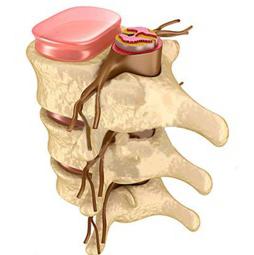

The spine of the person whose structure is responsiblethe main tasks of life, is the basis of the whole body, the support of the bones of the skeleton, skull, numerous internal organs, muscle mass and fatty deposits. The load on the spinal column is considerable, but the body weight is distributed evenly, part of the load lies on the ribs of the chest and pelvic bones. Thus, a conditional weight balance is observed.
Basic parts of the human spine: lumbar and sacral, thoracic and cervical. Upper section, cervical, consists of 7 vertebrae of different configuration and size. Below are 12 pieces of the thoracic part, they are much larger than the cervical and connect with the ribs of the chest. The thoracic part passes into the lumbar region of five vertebrae, and the main load falls on them. Then comes the sacrum of five inactive vertebrae.

The structure of the human spine is sufficientcomplex, multicomponent. It has a curved shape that allows you to maintain balance, and also gives the entire body the damping properties necessary for fast and sharp movements. The spine of the person whose structure we are considering is one of the most complex organs. It begins with the first and second vertebrae of the cervical region. The first, called "atlant" consists of bone arches and articulates directly to the base of the skull. The next "epistrophe" partially enters into the "atlant". Thanks to this pair, the human head can turn in different directions and bend over.

The remaining vertebrae are identical in shape and differ only in size. They are all surrounded by the muscles of the chest, abdomen, pelvis and back.
The spine of a person, the structure which is due to the multitude of functions thathe has to perform, is an vulnerable part of the human body. Even being immune to the immune system from attacking all sorts of viral infections, it is subject to mechanical effects. Even an easy, sometimes quite minor injury, inflicted from the outside, can disrupt its functionality. Not to mention the serious injuries with damage to the intervertebral articulations, which inevitably result in disability.

Vertebrae have a rounded shape with severalprocesses through which the body of a given vertebra articulates with its neighbors. The principle of alignment allows them to move in a certain amplitude. Disks of cartilaginous tissue, providing separation of bone surfaces, serve as an elastic lining between the vertebrae. Inside the spine along the entire length there passes a special hole-channel for the spinal cord - the basis of the hematopoietic system of the body. Any bias can squeeze the brain or even destroy it. The spine of a person whose structure is impeccable in terms of functionality, is still not immune from damage. Therefore, you should avoid overloading and traumatic body movements.
